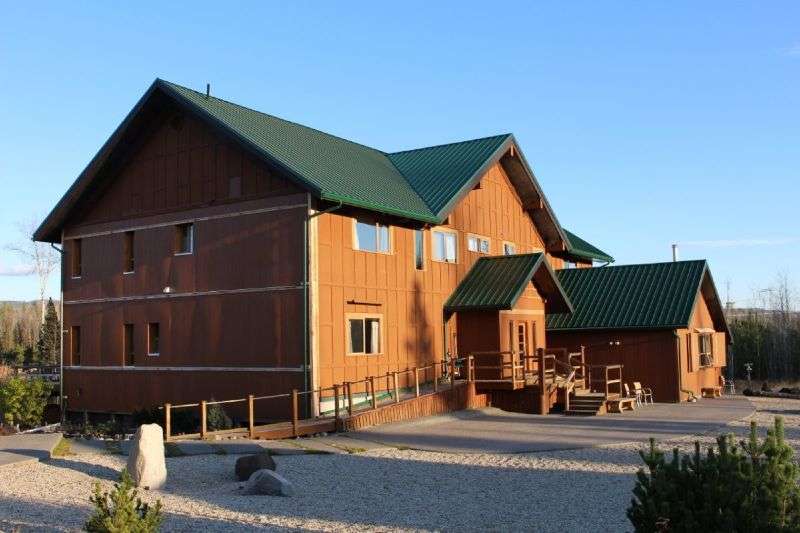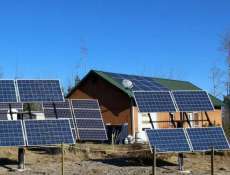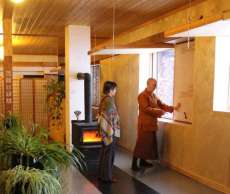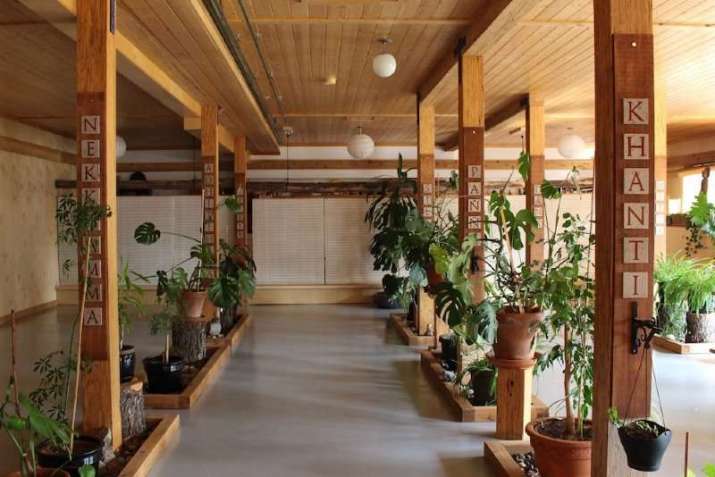
Birken Forest Monastery sits on 80 acres (32 hectares), surrounded by vast areas of crown land in the mountains of British Columbia, Canada. It is about eight kilometers from Kamloops, as the crow flies, although the road there is rather longer. You can be forgiven for not knowing exactly where Kamloops is, but for some reference, it’s a three-and-a-half-hour drive into the rugged BC interior from Vancouver.
The monastery is home to not only the abbot, Ajahn Sona, and the practitioners who gather there, but also to other beings who find safe haven there, including many species of deer, moose, and smaller animals, and the ducks, geese, and other birds who frequent the large marshy part of the property.
What inspired me to write about Birken is not actually their Dhamma practice, but their environmental activism, which I discovered in a video from 2018 that they posted on YouTube, titled “Energy Efficiency at Birken Forest Monastery.”
In the 19-minute video, Ajahn Sona explains how their main building is at the leading edge of energy-efficient structures around the world. Winters in BC are intense, yet the monastery is roughly 80 per cent more energy-efficient than typical residential buildings in Canada, qualifying for North American passive house standards.
Ajahn Sona’s YouTube channel has almost 12,000 subscribers, and many of his videos have been viewed more than 10,000 times. By way of contrast, the energy efficiency video has only been viewed 1,600 times. Nevertheless, it grabbed my attention!
It is a room-by-room walkthrough, describing the use of solar panels, state-of-the-art battery packs, passive solar heat sinks, retractable insulated window shutters, and sundry other techniques. The result is astonishingly effective.


By way of context, back in the 1970s and 1980s, I was a graphic designer in Toronto and Energy Probe was one of my main clients. I produced a bi-monthly magazine for them and their sister NGO, Pollution Probe. It was quite an education for me. The twin not-for-profits began life in offices loaned by the University of Toronto but managed in 1980 to acquire a stately if tired Victorian fixer-upper nearby, which they turned into a model of environmentally forward living, called Ecology House.* From composting toilets and a third-floor hydroponic garden to a Trombe wall on the building’s south face, Ecology House was off the grid in many cosmic ways as well as physical ones. The experiment in sustainability was ultimately unsustainable but that’s another story. The point is: they were a beacon in their time. To some, it seemed that they had been no more than a psychological outpost for nostalgic readers of The Whole Earth Catalog or pretentious readers of Canada’s country living lifestyle magazine Harrowsmith, and other such left-wing, socialist radicals. But to me, it was the root of a great tree I prayed would flourish. Now, all these years later, I had discovered a sangharama that not only honored the legacy of Ecology House but also brought it forward successfully into our current era—an era fraught with concern over a climate crisis created by our own hubris.
For those brief moments when we are able to lift our eyes from the immediate crisis of the pandemic, the unravelling of our planet lurks just beyond the horizon. The voices of those like Greta Thunberg are excruciating to hear and simply too difficult to bear for many of us.
And here is Ajahn Sona, showing the way forward—not only physically with sustainable living but psychically with a new hope-filled paradigm for the Anthropocene. This new paradigm is, in fact, nothing new. It is the Dhamma expounded by Shakyamuni Buddha some 2,500 years ago.
When I asked Ajahn Sona how environmental sustainability fit into his Theravada practice, he replied: “Environmental sustainability is intrinsic in the code of conduct for monks and nuns. Non-harm to humans, to animals, and to plants, and non-contamination of the natural environment are explicitly formulated in the rules for monks.”
In North America, the vast majority of Buddhist groups exist in urban settings. Yet many sanghas have managed to establish rural retreat centers across the US and Canada. I have been exploring how those organizations have—or have not—incorporated active environmental policies and practices. Just before the pandemic hit, I sent out a detailed questionnaire to 108 rural centers asking about their land use, building retrofits, and so on. While I received encouraging preliminary responses from some, other respondents admitted they knew little and did little in that regard. I was about to dig deeper when the world’s consciousness turned us all to more immediate and pressing concerns.
How do the Buddha’s followers view environmental activism? I asked Ajahn Sona where the suttas provide a scriptural foundation for his views. He replied: “The suttas which most contribute are loving-kindness suttas which advocate care and concern for all living beings. This means one must take care not to harm others inadvertently by pollution, negligence, or callous indifference to their support environment.”
This is not just Birken’s idiosyncratic initiative. Birken is one branch of a network of 35 Theravada monasteries around the world. Ajahn Sona has consulted with all of them regarding practical advice on ecological and energy efficiency topics. He regularly offers his accumulated experience to other abbots, particularly in cold climates in the US, Canada, and Europe.
This experience is freely offered to the wider public as well. As Ajahn Sona notes: “We happily provide public information on our website and full tours of our energy structures on YouTube, and each year or two we add new information as we continually progress and upgrade. We are happy to provide that resource and information. Perhaps not strangely, monks have a long historical record of non-harm to the environment and frugality in their lifestyles.”

I would like to live in a world in which Buddhist communities are in the vanguard of sustainable ecology, degrowth, and sanity. If the joy I feel in encountering such communities is the result of their actions in that regard, then truly the power of metta is there for all to see.
But enough of the emotional. Let’s talk dollars and cents.
When Birken Forest Monastery was established 20 years ago, prices for solar panels and batteries were very high, and they could only afford a few kilowatts of solar energy. But this paid itself back in savings on the diesel generator. The plain fact is that it is far too expensive to have an off-grid operation exclusively on a generator, and whatever solar costs, it is less than diesel or propane. As each decade has gone by, solar has dropped by 50 per cent and is now a tenth of the cost that it was. This year, Birken’s plan is to install 10 times the amount of their first installation, and for not much more than the price of their small original array of photovoltaics. Batteries also have improved immensely, moving from lead acid to modern, maintenance-free lithium batteries that perform radically better than the early technology. These new batteries are still expensive, but again they are more economical than operating a diesel generator. Anybody living in the year 2020 who endeavored to go off-grid could do so far more cheaply and with greater abundance than Birken was able to do over the past two decades. Alternative energy is heading in the right direction.
So I asked where they got the money.
Ajahn Sona: “I think it is a very sympathetic project. Most people in Buddhist communities would be delighted to donate to alternative technologies for power production. This could take the form of solar panels, heat pumps, and electric vehicles. That is how we have done it. All of these processes have been done strictly by donation and by people who particularly think it is a good use of donations for our alternative energy.”
Okay, so if money is not a barrier, is there perhaps some unique skill Ajahn Sona possesses that allows him to accomplish this complicated feat? I asked: “Was it all volunteers from within your sangha—not just the doing, but the research, planning, and number crunching?”
Ajahn Sona: “Primarily it is me, the abbot. I have taken a great interest, and strangely for someone with just high school level mathematics, I have delighted in learning about the economics and physics of these new technologies. I regularly contribute to green energy websites, sharing my experience with others and encouraging them.”
The rationale is not complicated. Birken Forest Monastery’s annual energy budget is about 10 per cent of their total income and they are happy to pay it. They have put enormous care and research into reducing their carbon footprint through insulation, careful design of buildings, and low energy appliances. Many of these projects required upfront funding but the benefits extend over many decades. In short, they have maximized their economic situation and at the same time maximized their efficiency.
The wider spiritual and ecological benefits of their action, however, are priceless.
* Open the house, close the door (Macleans)
See more
Birken Forest Buddhist Monastery
An Off-Grid Solar Community (Green Building Advisor)














